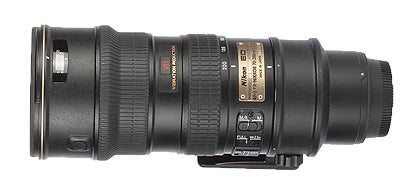Nikkor AF-S VR 70-200mm f/2.8G IF-ED lens takes advantage of the VR II vibration reduction technology. Is it a staggeringly different beast though? The What Digital Camera Nikkor AF-S VR 70-200mm f/2.8G IF-ED test reveals all...
Nikon AF-S 70-200mm f/2.8G ED VR Review
Thanks to its silent-wave motor the Nikkor AF-S VR 70-200mm f/2.8G IF-ED lens crushes the old criticism of slow and noisy focusing in Nikon optics. In fact the vibration reduction (VR) mechanism, quiet though it is, is louder than the AF drive.
As for its focusing speed, the 70-200mm is not only blistering quick but also very reliable. There can, however, be a very slight tug from the AF motor on the focusing ring, which can interrupt focusing when manual intervention is constantly being used.
That said, Nikon’s lens is very clearly designed principally for AF use because, with its tripod collar attached, the platform sits nicely in the palm of the hand with the zoom ring falling naturally under the fingers. The various switches for focusing and VR modes are within thumb reach but are not sufficiently well distinguished for blind use.

Such is the layout of the lens that it is possible to cultivate a violin-style grip where the various digits of the left hand all have a different function; the thumb and ring finger twist the zoom ring; the second finger rolls against the focusing ring; the first finger rests on the bottom focus-lock button. The trade-off is that the focused-distance window, which would normally be located mid-barrel, has had to be moved to the very front of the lens (and is also smaller and less legible than it might otherwise have been).
Technically, there is a difference in performance depending on which sensor format is used for testing. All results were very good but the better performance was obtained using a D700 with a full-frame sensor rather than a D80 with a DX sensor. This suggests that if you want to get the best out of a pro-spec lens then you should choose a pro-spec camera body. When that combination is used, as here, the results are not simply good but, to all intents and purposes, perfect: at no point did the 70-200mm’s MTF figures ever drop below the critical 0.25 cycles-per-pixel level.
There is still room for small improvements in the VR and AF systems but this is already a very competent lens.





